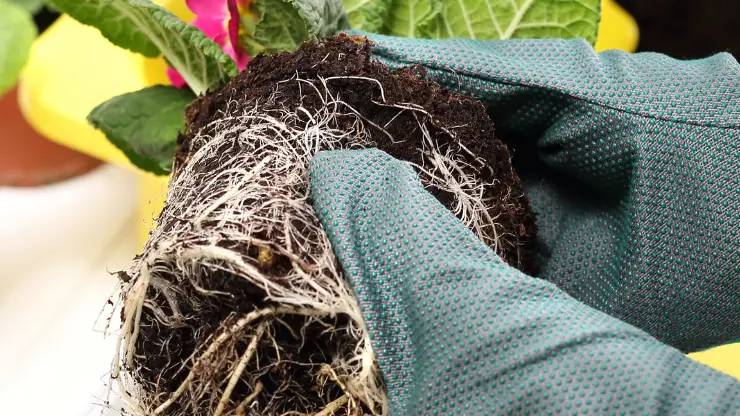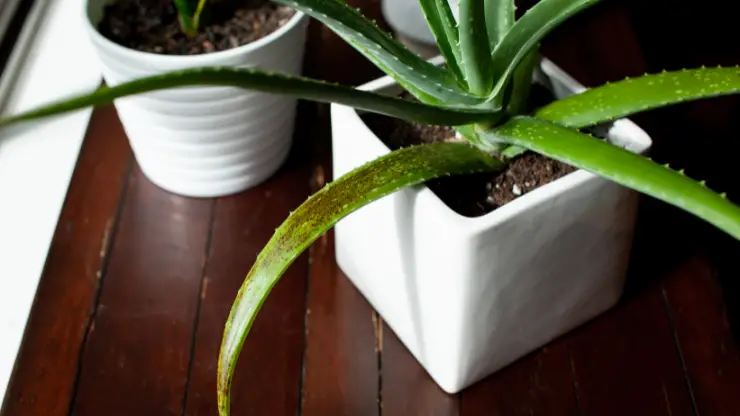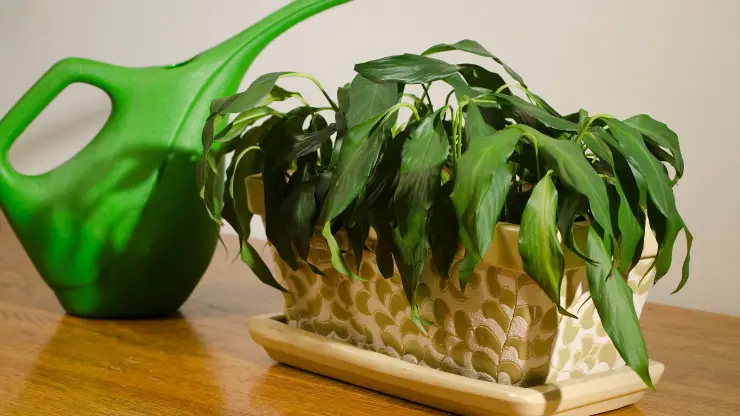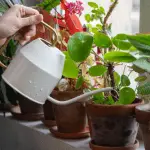If your plant is dying because it’s been given too much water, don’t lose hope. You may still be able to revive it – depending on the plant and the extent of the damage. In this post, I’ll show you how to fix overwatered plants in 5 easy-to-follow steps.
But, first make sure this is actually the problem. I have an entire post on how to tell if your plant is overwatered or underwatered, but I’ll also cover the basics of what to look for here.
Signs of Overwatered Plants
What does an overwatered plant look like? The following signs will tell you if your plant is struggling due to too much water:
- The container feels heavy or you can see standing water, but the plant still droops.
- Soil is soggy or wet, and the plant has droopy, yellowing leaves (waterlogged plant soil).
- Roots are brown and soft instead of firm and white (root rot).
If these symptoms are present, you most likely have a waterlogged plant. If your plant is drooping or yellowing but it does not appear to be watered excessively, you might want to keep troubleshooting to find the cause.
If you’ve determined that too much water is the cause of your problems, keep reading for instructions on how to fix overwatered plants.
How to Fix Overwatered Plants
In order to rescue an overwatered houseplant, you must act fast before the entire plant dies. If you have just noticed the wilting, you have a chance to save the plant. Some plants may never recover, but it doesn’t hurt to try.
Here’s how to fix overwatered plants in five steps:
Prepare a Drying Area
Place several layers of newspaper down on a sheet pan or shallow try. If you don’t have any newspaper available, use any absorbent material. A cloth dish towel or even paper towels will work in a pinch.
Expose Roots
Lay the plant on it’s side and gently pull it out of the pot, roots and soil included. If the plant is waterlogged, it should come out easily. Remove as much of the soil from around the roots as you can using your fingers.
You don’t have to remove every bit of soil, just whatever comes away easily when you brush with your fingers. Be gentle and try not to damage roots any further.
Allow to Dry Overnight
Place the entire plant on the newspaper, and allow it to dry overnight. Make sure the roots are completely on the paper. It’s okay if the foliage drapes over the pan or tray. It’s most important that the roots are on the absorbent material.
If you like, you can point a fan at the plant to help it dry, but this is not necessary. It should dry enough overnight without any assistance, as long as the room isn’t too humid.
Trim Damaged Roots
The next day, take a pair of clean, sharp scissors and trim away any mushy or dark-colored roots. A healthy houseplant’s roots should be firm and white, like these:

If ALL the roots are slimy or mushy, your plant may be too far gone to save. But if it still has some healthy roots left, you have a good chance of rescuing it.
Re-pot the Plant
Re-pot your plant in a clean container with fresh potting soil. Add a layer of small stones, pebbles, or pieces of a broken clay flowerpot to the bottom of the pot before adding the soil. This will prevent standing water from accumulating in the future.
Always use a well-draining potting soil formulated for houseplants. My favorite is this one by Happy Frog for most of my foliage plants. But keep in mind that succulents, cacti, and some other plants (like anthurium and calathea) may need special soil blends.
Overwatered Plant Recovery Time
In most cases, your overwatered plant will recover in 7 – 14 days if you follow the steps above. If there was extensive damage, it may take longer. But if there were enough healthy roots, it usually only takes about two weeks to see improvement.
After re-potting, water lightly and allow the soil to dry before watering again. Don’t make the same mistake you made before of giving the plant too much water – especially now!

How to NOT Overwater Plants
Now that you know how to fix overwatered plants, how can you avoid making the same mistake in the future? Here are some tips!
- Too little is better than too much. When you get a new plant, it is always better to water it too little than too much (until you know how much water it likes). Most houseplants can recover from underwatering easier than overwatering.
- Be careful in autumn. New growth slows as the days become shorter in autumn. As a result, plants typically need less water. Indoor humidity levels are usually moderate during the fall also, resulting in the need for less water.
- Increase watering in winter. As indoor humidity levels drop in the winter, you may safely increase watering until your plants are content. (By increase, I mean increase from autumn – not what you would give them in summer.)
- Water from the bottom. If you can’t stop yourself from overwatering your plants, try to water from the bottom instead of the top. Pour water in a saucer or tray. Set the plant in the water, allowing it to “drink” for up to 30 minutes. Then, remove the plant. DO NOT LEAVE A PLANT STANDING IN WATER FOR LONGER THAN 30 MINUTES.
- Water only when the soil is dry to the touch. For MOST PLANTS, water only when you touch the top of the soil and it feels dry (unless your plant’s care guide states that it should be kept moist at all times). If your plant likes to dry out between waterings, only water when you insert your finger into the soil and it feels dry up to the first knuckle.
- Avoid plants that need to be kept moist. If you’re the kind of person who tends to overwater, avoid houseplants that need to be kept moist. Instead, fill your indoor garden with plants that can dry out a bit so you won’t be tempted to water too often.
Houseplants typically require the most water in the warm summer months, but always check the specific care requirements for your individual plants. If you follow these guidelines and get to know your plants, you’ll never have to ask how to fix overwatered plants again.





